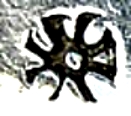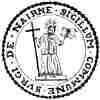by Robert
Massart
(click on photos to enlarge image)
Scottish Legends & Silver Hallmarks
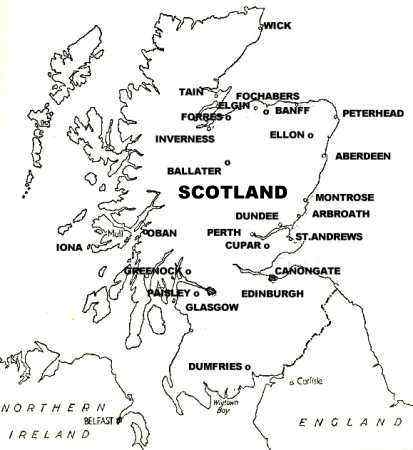 |
Scotland is well-known for his clans, the
fearless militaries going to the battlefield
preceded by their pipers and the unspoiled nature of
the Highlands with lochs, rivers, salmon and stags.
During historical times many myths, folk tales and
legends originated in this environment, even
affecting today’s practices of hallmarking silver.
Deciphering marks on silver items is a fascinating
pastime for silver collectors, but mostly they have
no idea of the background of these marks and the
reason why specific punches were chosen as town mark
or standard mark. The scope of this article is to
trace back the origin of Scottish silver punches to
the earliest times and to bring the reader
up-to-date on this subject.
Hallmarks were for most part, freely adopted by
individuals or clans at some point in the Middle
Ages and in many cases it is impossible to define
the meaning of it, if any.
In particular cases however symbols and emblems of
official seals were the source of town marks and
were subsequently integrated in city coat of arms.
As explained hereafter some punches are even linked
to Scottish legends, which is not surprising as
Scotland has an extensive heritage in that field.
(left) Location of cities and burghs
(note 1)
|
Thistle mark

|
In Edinburgh, the Scottish capital, a thistle
mark was used since 1759 until 1974 to guarantee
sterling silver, an alloy of silver containing 92,5
% fine silver and 7,5 % other metals, mostly copper.
This thistle mark was used as a national emblem of
Scotland. From 1975 to present the lion rampant
replaces the Thistle as the standard mark. According
to legend Scottish soldiers were forewarned of
Viking invaders by their screams as they were
wounded by thistles whilst creeping ashore.
(left: thistle mark)
|
Lion Rampant


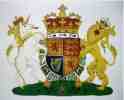
|
Sterling silver was guaranteed in Glasgow
with the Lion Rampant mark from 1819 till the
closure of the assay office in 1964. King William I,
‘The Lion’ (1142-1214) (note 2),
adopted the Lion Rampant for his Royal flag. The
lion is shown rearing up with three legs stretched
out and has been incorporated in the Great Seal of
Scotland and symbolises the strength of the Scottish
people and their ferociousness in battle.
|
Lion rampant (left)
Royal coat of arms of Scotland as used before 1603
(center) (note 3)
Scottish version of the Royal coat of arms of the
United Kingdom since 1603 (right)
|
|
Edinburgh town mark


|
The triple towered castle is a symbol for
Edinburgh, the Castle Rock having been fortified
since c.600 BC.
The town mark, taken from the burgh’s arms, has been
used as Edinburgh town mark from the year 1485 down
to the present day. The coat of arms was granted to
the Edinburgh Town Council in 1732.
|
Town mark (left)
Edinburgh coat of arms (right)
|
|
Glasgow town mark
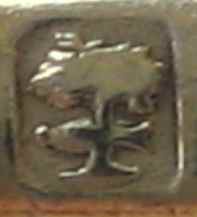
Town mark
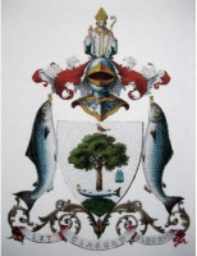
Glasgow coat of arms
|
Glasgow owes its existence to the river Clyde
flowing through it and during the Middle Ages it was
the last place where a bridge was built to allow
crossing the river without a boat.
The city did not have a coat of arms until 1866 when
a number of symbols and emblems, which had been used
before on official seals, were incorporated on it.
These symbols and emblems (oak, bird, fish and
square bell) were all associated with St Mungo.
(note 4).
The sturdy oak tree started out as a branch
of a hazel tree. A legend tells that St Mungo as a
boy was in charge of a holy fire in the St Serf’s
monastery and fell asleep. Some boys, jealous of his
favoured position, put out the fire. When St Mungo
woke up he broke off some branches from a hazel tree
and by praying over them he was able to restart the
fire.
The bird in the tree commemorates a wild
robin which was tamed by St Serf. Again some fellow
classmates, envious of Mungo, killed the bird and
blamed him for it. St Mungo took the dead bird,
prayed over it and restored it to life.
The fish with a ring in his mouth refers to
King Hydderch Hael of Strathclyde who had given his
wife Queen Languoreth a ring as a present. Instead
of keeping the ring the Queen gave it to her lover.
The King was informed by a servant of the affair and
laid a plot to denounce her. He went hunting with
the knight and when the young man fell asleep he
removed the ring off his finger and tossed it into
the river Clyde. The King then challenged his wife
to produce the ring, which of course she could not,
whereupon she was imprisoned awaiting her execution.
The legend tells that she sent a messenger to St
Mungo for help, who instructed the messenger to go
fishing and bring back the first fish he catches.
Another version relates that the knight asked for St
Mungo’s help who sent a monk to catch the first fish
in the river Clyde. When the salmon was brought
back, St Mungo cut open the fish and found the ring.
The ring was given to the Queen and saved her life.
The hand-bell It is thought that the square
bell was acquired by St Mungo on a pilgrimage to
Rome, but there is no definite information as to how
he obtained it. It was said to have been used in
services and to mourn the deceased. Priests’ bells
were important many centuries ago as people would
leave an endowment to pay for the bell to be rung
throughout the city to call the residents to pray
for their soul.
|
Scottish provincial silver ware, especially
from burghs in the Highlands, is very rare. The few
silversmiths being active in this area stamped their
pieces with their initials or full name alongside
the abbreviated name of the town or used the town
mark.
Some combinations of a maker’s mark and the town
name are for example: Charles Bruce of Peterhead (C.
BRUCE/P’HEAD), Alexander McLeod of Inverness
(AML/INS), Thomas Stewart of Elgin (TS/ELN)
|
Aberdeen
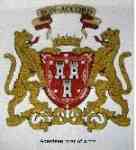
|
The three castles represent fortifications
that stood on three hills around which Aberdeen
developed during the reign of King Robert the Bruce.
The legend of Robert the Bruce relates that he was
at war with the King of England who tried to conquer
Scotland.
Six times he fought against the English but each
time his army had been beaten. At last Robert the
Bruce’s army was scattered and he was forced to flee
and hide out in a cave. There he observed a spider
spinning a web. The spider failed six times, but
each time it tried again until it succeeded. The
perseverance of the spider inspired Robert the Bruce
to organise an army of brave men around him and
fight the English invaders again. Finally, in 1314
at the battle of Bannockburn he defeated decisively
his opponents and assured Scotland’s independence.
Place names with 'aber' are common on the
East coast of Scotland. Aber is a Celtic word
meaning ‘confluence of waters’ or ‘river mouth’.
(left: Aberdeen coat of arms)








|
Arbroath
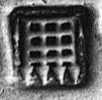
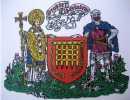
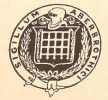
|
The burgh of Arbroath probably used a
portcullis to symbolise strength and redoubt ability
of his citizens.
The silver mark is based on the Arbroath burgh seal.
Arbroath, formerly Aberbrothick, is the anglicised (contracted)
form of aber.
|
Canongate


|
According to legend King David I of the Scots
was hunting during a Holy Day in 1128, when out of
nowhere a magnificent male red deer attacked him and
threw him from his horse. The King tried to protect
himself against the antlers by raising his arms. At
that moment a crucifix appeared between the antlers
of the stag and when he held the cross the stag
calmed down and walked away. In gratitude for his
miraculous escape from the enraged stag David I
established the same year a monastery at the site
and granted a charter to the adjacent burgh which
was to become Canongate.
|
Dundee



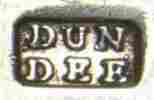

|
(note 4) The three lilies first appear on the seal of
the city in 1416 and symbolise St Mary, one of the
two patron saints of the city (St. Clement I being
the second patron saint of Dundee). The lilies are
flowers of purity and had strong religious
connotations, especially with the Virgin Mary. The
lily also appears as a crest in the full coat of
arms of Dundee.
|
Elgin
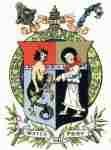
|
St Giles, a 7th century hermit, who lived in
France, became the patron of Elgin, probably due
to the ancient ties between Scotland and France.
According to legend, Giles was accidentally wounded
by a huntsman in pursuit of a hind. The saint is
usually depicted protecting a hind from an arrow,
which had pierced his body.






|
Forres



|
The mark refers to Nelson’s tower, situated
on top of Cluny Hill in Forres. The tower was built
in 1808 as a memorial to Vice Admiral Horatio Nelson
to commemorate his victory over Napoleon’s fleet at
Cape Trafalgar in October 1805.
|
Greenock
Cartsburn and Easter Greenock existed as a
single estate since the rule of Mary Queen of Scots.
A small fishing village was established there
sometime prior to 1592. Around 1669 Greenock was
established as a port. The anchor
(note 6) and a ship in full sail clearly
refer to the port and the importance of shipbuilding
in the burgh. Jackson (p. 604) states that the green
oak is a pun on the town’s name and not a pointer on
its derivation.

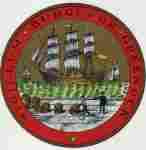





|
Inverness
The camel (in fact a dromedary) is part of
the town’s early coat of arms and is thought to
represent the burghs thriving Eastern trade links
(note 7). The burgh’s
later seal and coat of arms represents a camel and
an elephant. Ultimately Inverness lost its coat of
arms in 1975 with the formation of the Highland
Council.
The earliest known camel mark (used by the
silversmith Robert Anderson) dates from 1760 (ref.
page 607 in Jackson’s Silver & Gold marks of England,
Scotland & Ireland).
In the areas of the Western Highlands and the
Grampians, Inver is a common element in place-names.
Just like the word aber it means 'confluence of
waters’ or ‘river mouth’.
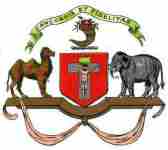





|
St Andrews

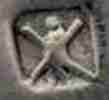


|
Several legends relate that the relics of
Apostle Andrew (crucified in 62 on a diagonal cross)
were brought under supernatural guidance from
Constantinople to the town of St Andrews.
According to one legend King Ungus, fighting the
English with his army during the late eight century,
saw a cloud in the shape of a saltire. He felt
protected by St Andrew and promised he would become
their patron saint if they won the battle.
Another legend narrates that a Greek monk, Saint
Regulus or Saint Rule, was warned in 347 by an angel
to take the relics of the Apostle Andrew and go West
by ship. That way he could avoid that Emperor
Constantine would remove the bones to Constantinople.
Saint Rule fled with the relics to Scotland and
shipwrecked at the village Kinrymont (now St Andrews).
He founded a church at that spot, where he buried
the bones of the Apostle.
Around the tenth century Andrew became the patron
saint of Scotland and the diagonal cross forms the
national flag of the country.
|
Conclusions
This write up has not the intention of an in-depth study; it
is only a first attempt to reveal the origin of some Scottish
and Scottish Provincial silver marks. Hopefully it will enhance
the interest of other silver collectors to look out for the
origin of other Scottish town marks, such as:


CUPAR: Fleur de Lys (marks used by Robert
Robertson)
|






DUMFRIES: stag’s head, coiled anchor, unicorn, Medieval castle ruin
|




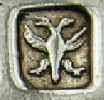
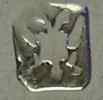



|
PERTH: double headed eagle
(note 10), lamb bearing the banner of St.
Andrew (earliest town mark 1675-1710 on the left).
|




|
PETERHEAD: anchor, P’HEAD, PHD
|


|
TAIN: sunburst, TAIN
|

|
WICK: WICK
|
(note 1) In Scotland a settlement with a diocesan
cathedral, headed by a bishop, used to be defined as a city.
Before the creation of cities some towns were granted the status
of a Royal Burgh by a charter from the King; most of them during
the reign of King David I (1124-1153).
(note 2) The unicorn is a symbol of strength, endurance,
agility, perseverance, wisdom and playfulness. The animal is
also a symbol of purity, hope, love and majesty, grace, finesse
and unconquerable nature. It was thought that his horn offered
protection against poison. When James I ascended to the English
throne in 1603, the heraldic unicorn and lion represented the
union of two formerly enemy nations.
(note 3) William I reigned as King of Scots from 1165 to
1214. He was an effective monarch whose reign was marred by his
ill-fated attempts to regain control of Northumbria from the
Normans.
(note 4) A legend tells that princess Theneu became
pregnant before marriage and therefore she was thrown from a
cliff in the river Forth. She survived, met an unmanned boat and
drifted across the estuary. Finally she landed at Culross where
she gave birth to St Kentigern and was taken care of by St Serf.
It was St Serf who gave Kentigern his pet name Mungo, meaning
‘my beloved’. St Mungo started his preaching near Glasgow and
lived an austere life. Following an anti Christian movement he
left the district and moved to St Asaph, from where he took a
pilgrimage to Rome. When the new King of Strathclyde invited him
to return he did so and died there in old age on 13th January
613. Legend has it that St Mungo founded Glasgow in 543 when he
established a church on the banks of a tributary of the river
Clyde. He therefore became the patron saint of the city of
Glasgow.
(note 5) Dundee was granted the status of Royal Burgh in
1191 by William the Lion. It is said that when William returned
from the Crusades he barely escaped death by drowning and that
his brother David named the burgh therefore Deidonum (God's gift).
(note 6) The best known anchor mark is of course the town
mark of Birmingham, in use since 1773. The reason this mark was
adopted at that time is not related to a port at all (Birmingham
is not located near the coast) but refers to an inn called the "Anchor
and Crown" where a meeting was held by councils to decide upon
the symbol for the town mark.
(note 7) The collection of the Inverness Museum & Art
Gallery contains a 17th century burgh seal representing a camel.
(note 8) Permission for reproduction granted by St
Andrews Community Council.
(note 9) Saint Ninian (c. 360 - 432) is the earliest
known evangeliser to have visited Scotland north of Hadrian’s
Wall. According to legend he is buried at Sanda Island and
whoever stepped on his grave would die.
(note 10) The double-headed eagle, a symbol of power, can
be traced back to the Hitite civilisation (1700 BC-1200 BC).
During the 12th century the symbol was used in Constantinople
and from 1250 on the double-headed eagle symbol was adopted by
several Empires, Kingdoms and Confederations (Austria, Russia,
Germany, …)
Before the reign of King David I towns did not exist in
Scotland. During his reign King David I created Royal burghs by
granting prerogatives by Royal chart to important population
concentrations around monasteries and fortifications. Most Royal
burghs were seaports and acquired a monopoly of foreign trade.
These burghs were for the most part populated by foreigners,
rather than native Scots. The predominant ethnic groups were the
Flemings (people from Flanders). The reason of it was that in
1066 not only Normans but many Flemings followed William the
Conqueror to England. They were offered territories in Scotland,
which resulted in a strong Flemish presence in the Medieval
Scottish court.
|
Burgh
|
Period of Charter
|
Patron Saint or
Figure on Seal
|
Remarks
|
Aberdeen
|
David I
|
St Nicolas
|
The area around Aberdeen has been settled for
at least 8000 years
|
Arbroath
|
James VI (1599)
|
St Thomas a Becket
|
Arbroath remained a small village until 1178,
when King William the Lion founded an abbey, which
was completed in 1233.
|
Ayr
|
William I (1202)
|
St John the Baptist
|
In 1197 William the Lion built his castle at
the mouth of the river Ayr and established the royal
burgh in the area which he granted the right to hold
markets and the freedom for overseas trade through
the harbour.
|
Banff
|
William I
|
St Mary
|
Early 12th century the first castle was built
to defend the coast against Viking invasion.
Confirmed as Royal burgh in 1372 by Robert II.
|
Canongate
|
.
|
.
|
Canongate, now part of Edinburgh, is the area
of the Old Town of Edinburgh.
|
Culross
|
James VI (1588)
|
St Serf
|
Birth place of St Mungo and port city on the
estuary of the river Forth. An abbey was founded
here in 1217 by Malcolm, 7th earl of Fife.
|
Cupar
|
David II (1363)
|
Holy Trinity
|
Situated between the larger towns Dundee and
Glenrothes.
|
Dumfries
|
David I
|
St Michael
|
Located on the east side of the lowest
crossing point of the river Nith, Dumfries grew
rapidly as a market town and port.
|
Dundee
|
William I
|
St Mary & St Clement
|
Dundee is the fourth largest city in Scotland.
|
Elgin
|
William I
|
St Giles
|
Confirmed as Royal burgh in 1457.
|
Fochabers
|
.
|
St Andrew
|
Village built in the late 18th century,
located not far from the city of Elgin.
|
Forres
|
William I
|
St Laurence
|
The saint figures on the coat of arms of the
burgh
|
Greenock
|
Charles I
|
.
|
Established as a small village prior to 1592.
It was quickly established as a port and developed
to a large town.
|
Inverness
|
William I
|
St Mary & Crucifixion
|
Early in the 12th century King David I
(1124-1153) made Inverness a royal burgh. In the
late 12th century King William the Lion gave
Inverness 4 charters.
|
Montrose
|
David I
|
St Peter
|
The name Montrose is probably derived from 'Mouth
Hrossay' due to the location of the burgh at the
outlets of the river Esk near Rossie Island (Norse
for horse island).
|
Nairn
|
William I
|
St Ninian
|
The royal burgh of Nairn, located between
Forres and Inverness, is said to have been
originally founded by William the Lion, and derives
its name from the river Nairn, on which it is
situated.
|
Paisley
|
James IV
|
St Mirin
|
A priory was established in 1163 and raised
to the status of an abbey in 1245.
|
Perth
|
David I
|
St John Baptist
|
Perth was a Royal residence throughout the
Middle Ages.
|
Peterhead
|
.
|
St George
|
Founded by George Keith the 5th Earl
Marischal in 1593. Peterhead became a fishing port.
The whale trade was at its peak in the mid 1800s.
|
St Andrews
|
David I (1140)
|
St Andrew
|
From medieval times until the Reformation,
St Andrews was the ecclesiastical capital of
Scotland.
|
Tain
|
Malcolm III (1066)
James VI (1587)
|
St Duthacus
|
Tain is Scotland's oldest Royal Burgh.
|
Wick
|
James VI (1589)
|
St Fergus
|
The earliest harbour works started in 1803.
|
Source: Preliminary Notice of the Seals of the Royal
Burghs of Scotland, by James Urquhart
|
|
 ASSOCIATION OF SMALL COLLECTORS OF ANTIQUE SILVER
ASSOCIATION OF SMALL COLLECTORS OF ANTIQUE SILVER
























































